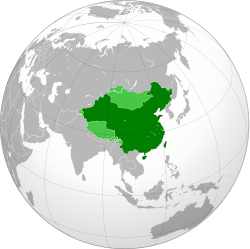Empire of China (1915–16)
| Empire of China | ||||||||||
| 中華帝國 Zhōnghuá Dìguó |
||||||||||
|
||||||||||
|
||||||||||
|
Anthem Zhōngguó xióng lì yǔzhòujiān 《中國雄立宇宙間》 "China Heroically Stands in the Universe" |
||||||||||
|
Location and maximum extent of the territory claimed by the Empire of China.
|
||||||||||
| Capital | Beijing | |||||||||
| Languages | Chinese | |||||||||
| Government | Absolute monarchy | |||||||||
| Emperor | ||||||||||
| • | 1915–1916 | Hongxian Emperor | ||||||||
| Prime Minister | ||||||||||
| • | 1915–1916 | Lou Tseng-Tsiang | ||||||||
| Historical era | World War I | |||||||||
| • | Established | 12 December 1915 | ||||||||
| • | National Protection War | 25 December 1915 | ||||||||
| • | Disestablished | 22 March 1916 | ||||||||
| Currency | Chinese Yuan | |||||||||
|
||||||||||
| Today part of |
|
|||||||||
The Empire of China (simplified Chinese: 中华帝国; traditional Chinese: 中華帝國; pinyin: Zhōnghuá Dìguó) was a short-lived attempt by statesman and general Yuan Shikai from late 1915 to early 1916 to reinstate monarchy in China, with himself as the Hongxian Emperor (simplified Chinese: 洪宪皇帝; traditional Chinese: 洪憲皇帝; pinyin: Hóngxiàn Huángdì). The attempt was ultimately a failure; it set back the Chinese republican cause by many years and fractured China into a period of conflict between various local warlords.
After Yuan Shikai was installed as the second Provisional Great President of the Republic of China, he took various steps to consolidate his power and remove opposition leaders from office. To secure his own power he collaborated with various European powers as well as Japan. Around August 1915, he instructed Yang Du (楊度) et al. to canvass support for a return of a monarchy. On 11 December 1915, an assembly unanimously elected him as Emperor. Yuan ceremonially declined, but "relented" and immediately agreed when the National Assembly petitioned again that day. On 12 December, Yuan, supported by his son Yuan Keding, declared the Empire of China with himself as the "Great Emperor of the Chinese Empire" (simplified Chinese: 中华帝国大皇帝; traditional Chinese: 中華帝國大皇帝; pinyin: Zhōnghuá Dìguó Dà Huángdì), taking the era name Hongxian (simplified Chinese: 洪宪; traditional Chinese: 洪憲; pinyin: Hóngxiàn, "Constitutional Abundance"). However, Yuan, now known as the Hongxian Emperor, delayed the accession rites until 1 January 1916. A dress rehearsal was sabotaged by his Korean concubine. Soon after, the Hongxian Emperor started handing out titles of peerage to his closest relatives and friends, as well as those whom he thought he could buy with titles.
...
Wikipedia



